David Palmer’s show at the William Turner Gallery in Santa Monica opened last weekend. I’ve been intrigued by David’s work since I first saw it on his web site, and I’d been pestering him for an interview, which we finally did by email. I found it a fascinating view into the ideas and materials and process of David’s art making. It came out long, but it’s all good stuff. Just cowboy up and read it!

Major Motion Picture (Forever Almost Falling, 2006)
Steve:
You have grouped your recent work into two major projects, “Subcultures” followed by “Forever Almost Falling.” The division reflects a change in media from painting to linoleum, except for two linoleums included in “Subcultures.” There are other formal aspects, such as the appearance of dots (small, dark holes) and spots (small disks) in place of the larger lenses and other circle-based forms. The larger shapes seem to become more organic, and because they live or swim in a background that is linoleum rather than painted, they seem to inhabit a simpler space.
Can you say something in general about the transition from one project to the next? Are the pieces strictly divided chronologically? How apparent to you was the transition at the time? Did a change in concept drive the change in medium, or vice versa? There is certainly an overall continuity of concept, despite the various changes. Do you consider these projects to be expressions in different media of the same concerns, or is there a significant evolution of your conceptualization of what your work is about?
David:
I tend to think of my work in series’, never as individual pieces. At certain points I’ll go back over what I did, take a look at it in context, and regroup things in a way that makes sense to me in retrospect. Sometimes this is for artistic purposes, and other times it is in order to present the work in a cohesive way to an audience. It’s usually a combination of the two. When I shift from one project to another I’m very aware that I’m pursuing new territory, but I don’t know where it’s going to lead. It’s like beginning a new journey. I may take some time gathering information for the trip, but once I start it takes on a life of its own.
One series leads to the next, and that’s true of the individual works within them as well. It’s as though the working process generates seeds of ideas, and those grow into new works, which in turn generate their own seeds. Mixed in with this is all the stuff that comes from outside the studio, like things I read, films, conversations, and observations. But since I’m constantly involved in the process of making and thinking about art, these things are all seen in that context. I have volumes of journals full of ideas that may or may not find their way into my work. Sometimes they’re immediately applicable to what I’m working on, and other times it could take years to find a use for them.
In terms of the series’ on my website, here’s a short synopsis of how they evolved.
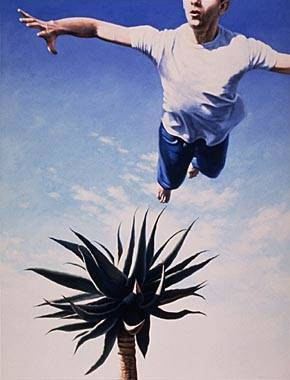
Attempts at Flight #16 (American Dreams, 1992)
The earliest work there is grouped under the heading American Dreams, and is just a small sampling of images from that period of 10 years or so. It was in fact made up of a lot of smaller series’, such as the Attempts at Flight paintings (I did over thirty of them), the Divining paintings, the people with snakes, and so on. I looked at what I was doing during that period as a sort of Dream Realism. The paintings were meant to be very realistic, but not in the way a photograph or a view out the window is realistic. They were meant to feel real in the way we experience images in dreams, or in memory. The name “American Dreams” came about in 2001, when a curator asked me for a title for my upcoming museum show.
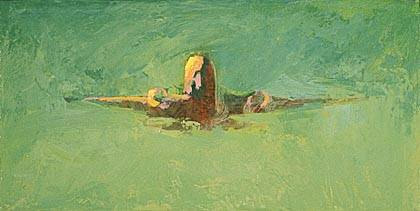
LAX #17 (LAX, 2001)
During the time I was painting the American Dreams images, I worked as a digital artist on the film Air Force One. Our crew used to go down to the airport and watch the planes land. Seeing them made a big impression on me, and I starting including airplanes in some of my paintings, such as JFK. I was also feeling the need for a shift in my work, and ended up doing a whole series, LAX, in which I used the planes and various color fields to capture the surreal experience of seeing them appear at the horizon and come in to land. This was part of a move for me away from realistic representation.
When flying, I always try to get a window seat. I can spend hours watching the ground move past down below. It’s like one amazing continuous painting. I have sketches in my journals going back at least 20 years of rivers, roads, farms and cities seen from above. Quick notations about something I wanted to capture someday in my work.
When I decided I was ready to do so, after the LAX paintings, I started looking at satellite photos and maps, and thinking about how I wanted to paint these aerial views. I already had a title, Flatlands, and I knew that these would be abstract works. But I didn’t want to paint them using all the techniques I’d used in the past. I went around thinking all the time about what different methods I could use to get the paint on the canvas. One day I was in Home Depot looking for a sander, and I happened to walk down the flooring aisle. I saw all these linoleum tiles, with their different colors and patterns, and one of those cartoon lightbulbs appeared above my head. I bought a few tiles, took them to the studio, and started cutting them and trying to figure out how to make images. I glued the pieces to a panel, hung it up on the wall, and realized I’d found my new medium. Then I discovered Linoleum City, an incredible flooring dealer here in L.A., and it became my favorite art supply store.
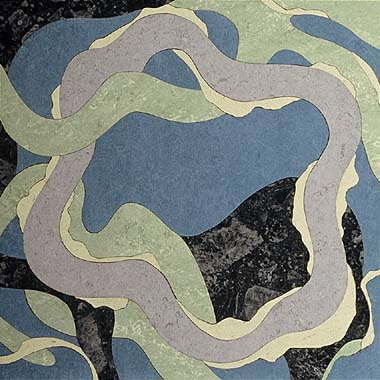
Flatlands #51 (Flatlands, 2002)
Over the course of doing the Flatlands work, I started noticing the similarities between aerial views of the earth and images of the microscopic world. In a sense, both of these worlds, the macro and the micro are invisible to us under normal conditions. The series evolved from being just about aerial views to being about micro views too, and I was exploring ambiguity of scale and point of view. Things that could be read in more than one way. In a sense I was doing this in the American Dreams paintings with meaning and metaphor, encouraging multiple readings, but here it was taking place on the visual level as well. The earliest works in this series were literally based on satellite photos, but my process very quickly became improvisational. Like playing jazz.
I tend to use a solo exhibition as an opportunity to take a look at a body of work, try to get a sense of what I’ve done, and think about what to do next. If there’s going to be a shift in direction, it often starts taking form then. That’s what happened when I had my Flatlands show in 2003. I had been thinking about what it would be like to do paintings that explored the territory I’d been discovering working with linoleum. The ambiguity of scale, the increasingly organic forms, and also the edge quality that occurs naturally with linoleum by cutting forms out.
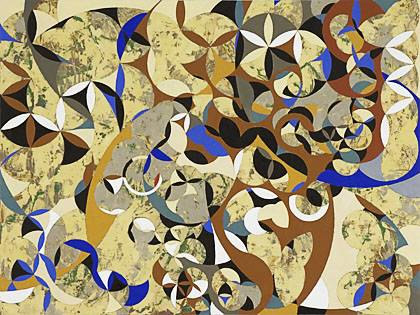
Search Engine (Subcultures, 2005)
After the show I started painting, and went back and forth for awhile between making paintings and linoleums. I wanted the two mediums to inform each other, but the paintings were the new medium at this point, so I was doing more of them. Before long I had enough paintings for a show, but I had in mind that my next exhibit would contain works in both mediums, so I started doing linoleums again. The paintings in this series were very different from the way I had painted before, and had more in common with the Flatlands linoleums that had preceeded them. But they were also different from the linoleums. They were naturally more gestural, and the edges had to be defined deliberately rather than simply resulting from the medium. And when I went back to making linoleums again, I found they they had been influenced by the new paintings! Much more gestural than the Flatlands linoleums, getting further from aerial imagery and much more into the imaginary microscopic realm.
I arrived at the title for the body of work, Forever Almost Falling, from something I read in Kevin Kelly’s book Out Of Control. Here’s the quote: “… if a system rests on the crest balanced between rigidity and chaos, then you’d expect its adaptive nature to pull it back onto the edge if it starts to drift away…A self-reinforcing sweet spot… It is the same forever almost-falling that poises the chemical pathways of the Earth’s biosphere in purposeful disequilibrium.”

Tibet (Forever Almost Falling, 2007)
It’s basically about how nature constantly improvises, finding a stablity of sorts by riding on the edge of chaos. It’s a lot like making art! So this was my working title for the series, and it gave me a framework for thinking about what I was doing. Eventually I had enough work for two or more shows, but it turned out that my gallery here in L.A. didn’t respond to the paintings, and just wanted to show the new linoleums. So I decided to use Forever Almost Falling as the title for the show of linoleums.
For the website I created another category, Subcultures, to present the paintings that preceeded the work in the show. There were a few interim linoleums, including Tipping Point and Cascade, that were from that earlier period (and they’re not in the exhibition), and I’ve left them in that section for now. So even though I had originally seen all the work in both FAF and Subcultures as being part of one series, I’ve split them into two for presentation purposes. I want visitors’ attention to be directed more toward the work in the current show, and chronologically it is the most recent.
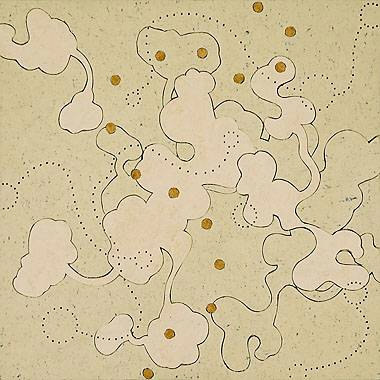
Siena (Forever Almost Falling, 2006)
The rows of dots you mentioned are a recent addition to my vocabulary in this medium. I had been looking for ways to reintroduce drawing elements into my work. When my wife and I were in Italy last April, I was blown away by something I saw in Siena. The floors outside the Duomo were inlaid marble representations of saints, all done in grayscale. And the artists had drilled little holes in the marble, creating dotted lines to define some of the features. When we returned to L.A. I immediately went to the studio, got out my Makita, and started drilling into linoleum.
Steve:
It seems that the idea of system is fundamental to both the how and the what of your work. A system implies not only entities but a network of connections among these. You work on multiple pieces at a time, and I gather that what’s happening in one will affect what’s happening in others. Can you give a specific example of that interaction? When you got the idea of holes from Siena, did you go back and alter older pieces? Is this process what you mean by poising your activity on the crest of disequilibrium, all things moving together to keep the momentum of ideas from collapsing or disintegrating into separate bits?
In the linoleums themselves, there are interacting networks consisting of the overlapping, elongated organic shapes with bulbous sections (reminiscent of neurons synapsing on each other), the implied relations among dots of a color (made more explicit in “Kevin Bacon”), and the lines of holes weaving in and out. Are there some design principles, some rules that govern these networks and the interconnections?
David:
When I paint I do work on several pieces at once, but with the linoleums I tend to work on one piece at a time. More specifically, I work on them in batches, in the sense that I’ll bring a bunch of them up to a basic point of completion, one at a time, and then I’ll glue that batch, and clean them up. Then I’ll sketch out the linear elements on each of them and drill the holes. The different working methods are probably determined by the logistics of working with the different materials, cutting out shapes as opposed to mixing and applying pigments.
But there are a number of ways that the pieces do interact. For one thing, whenever I cut a shape out of a piece of linoleum, I have a negative shape left over. Often the leftover shape is more interesting than the one I thought I was creating. So over time I end up with lots of leftover shapes, and I’ll use these in other compositions. They are a source of surprise, and help to prevent me from overly preconceiving the images. And of course there’s also the fact that, like with paintings, one image leads to the next, so a train of thought is set in motion and I follow it.
When we got back from Italy, after seeing the marble floors in Siena, I immediately went to the studio to try creating dotted lines in the linoleums. I was tempted to drill into the pieces I’d already completed, but decided against it. I had one piece that I was going to discard anyway, so I used that as a test, just to make sure it would work. Once I saw that it did, I used the drilled dotted lines in all the new pieces that followed. The first one I did this way is called Siena. I deliberately kept it pretty simple and low-contrast, because I wanted to see the effect of the lines, and not have them overpowered by color contrasts. As a rule, I tend not to go back and rework earlier artwork. If I have an idea I want to explore, I’ll integrate it into new work moving forward.
The idea of poised disequilibrium doesn’t really apply so much to finished work, since when it’s done it’s done, but more to work in progress.
Regarding design principles, I don’t consciously employ any in this work. It’s all very improvised. But I do think that what happens, over time, is that you are constantly developing and refining your perception and intuition, so that of course comes into play. In terms of rules, that’s another matter. Each work (or sometimes groups of works) tends to generate it’s own set of rules, and discovering what those are is part of the process of creating the piece.
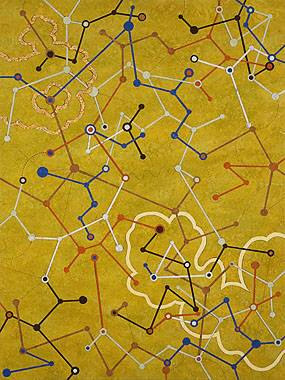
Kevin Bacon (Forever Almost Falling, 2007)
When I had the idea for Kevin Bacon, for example, I knew that I wanted a series of networks where all the nodes were connected. But I didn’t have a sense of how the different networks would connect with each other. At some point I realized that the networks, which were different colors, would connect at nodes that had one color nested within the other. So where a green and an orange network join, you’d have a node made up of two dots, a green and an orange, one encircling the other. Once I came up with that simple solution it created an underlying logic for the whole piece. It was all improvised, but there was a conceptual structure holding it together. The finished piece makes me think of a subway map. A train system designed by a crazy person :)
The idea of systems and networks has been driving much of the work in this series, but I’m conscious of not wanting to just illustrate concepts. It’s more that the concepts inspire certain types of forms and relationships, and I allow them to find their way in.
There are many many ways in which things can be connected. They can be connected physically, either directly or through a network. One thing can be nested within another. Things can be connected temporally, as parts of a sequence. They can be part of a grouping, and their connection can be based on proximity, or similarity. Those are just a very few examples, but they’re the sorts of things that are in the back of my mind when I’m working.
Steve:
I love the sort of fractal idea that things look similar at the scale of the landscape seen from a plane and the microscopic scale of cells in the body or molecules in the cell. One difference is that the landscape is well-described as a “flatland,” whereas the biological systems are truly three-dimensionally entangled. Most of your linoleums seem to adhere to strict overlapping like river over land, or road over field. Only “Major Motion Picture” and “Kevin Bacon” more clearly build into the third dimension by interweaving shapes. Do you think explicitly about the dimensionality?
David:
When I started working with linoleum, my idea was really driven by viewing landscapes from above, in map-view. Things flatten out from that vantage point, even though the land itself is very dimensional. Biological systems are dimensional as well, and tangled, as you mention, but I think of the top-down microscope view as flattening that world out too.
I’m interested in representing depth, but have limited myself to certain visual devices. I use overlapping, primarily, as well as color contrast, but have forbidden myself from using shading, lighting or perspective. I want this to be a symbolic world as opposed to a literally representational one, and these are some of the decisions I’ve made to keep it in that realm.

Babel (Forever Almost Falling, 2007)
However, I have found lately that the space I’m creating is more of a floating space than a strictly top-down view. As a result, there are sometimes indications of up and down, gravitational forces, and a more tangled dimensionality. I’m also finding myself allowing certain representational elements to reappear in my work, after totally eliminating them for awhile. One example of this is in Babel. The white splash-like shape is the exhaust trail of the space shuttle Challenger, which exploded on takeoff.
Steve:
You mentioned the linear element that enters automatically due to slight gaps between the linoleum pieces. In some of the newer pieces — “Tibet” and “Kevin Bacon” and “Babel” — you give this boundary a width of linoleum, while in “Saint” and “Macbeth” you invoke line with no contrast of materials on either side. Has the importance of line changed through the series? Do you think about line independently of the shapes bounded by it?
David:
Yes, there is already a certain linear quality that occurs naturally at the boundaries of shapes, and I’ve been encouraging that by varying the line width, and making sure there is enough of a gap to for it to read clearly. But as I work with these materials that lend themselves so naturally to creating forms with color differences, I find myself wanting to employ another, more subtle (and in some ways more abstract) way of defining form, by use of just line.

Saint (Forever Almost Falling, 2006)
I first tried this out in Major Motion Picture, where there are some shapes that overlap other shapes of the same color, and where they do so the shape is defined only by line. I did this again in the Grace triptych, and as you mention in Saint and Macbeth. It’s especially interesting for me now that I’m also employing that drilled dotted line I brought back from Italy, as now there are two kinds of line interacting.
My vocabulary in this medium is expanding. I started out by deliberately eliminating many of the devices I was so familiar with from painting, but I’m slowly reintroducing some of them. It was important at the beginning to start fresh and not rely on old habits. But now it’s time to integrate my earlier discoveries with the ongoing new ones.

PS – Karl, so tell me more about the big lab and the grad students :)
David,
I was thinking about this point also, mass production. The paradox, as you say, is that an artist needs to mass-produce originality. Since that is impossible by definition, something else has to give. Either the artist gives up on the idea of making it economically, or somehow the normal rules of economics get suspended when someone decides that the work is “hot” and then the price goes way up.
About the lab and students, in science you would be paid for the equivalent of making the work getting the exhibition up in the gallery. You wouldn’t on top of that be expected to do a magic trick and sell everything in multiple markets. You would have a group of dedicated and well trained people to help you in the work you needed to do.
The obvious solution, of course, is out-sourcing. This raises the question, can a culture outsource itself? I don’t think it can, and I think this may account for the survival of artists in our society.
Karl, regarding outsourcing, many successful artists design their work and then have it fabricated by others. Not just big sculptures, but paintings too. Damien Hirst had a show a couple of years ago of figurative oil paintings that were completely painted by assistants. His reply, when asked about it, was “does an architect build his own buildings?”
Regarding giving up on the economics, that’s what I’m doing at the momemt. I have no immediate plans to quit my day job. This past year, in addition to creating the work for my show (which I’m delighted is doing well), I recreated half of NYC in the computer (as part of a team, not all by myself) for the next Spiderman movie, and right now I’m painting a zombie rat for a film starring Will Smith. What could be better?
I get to work with people who are much smarter than me, I have health insurance, and I know that I can pay my rent and buy linoleum. So I’m not complaining. Whatever money I make from this exhibition will be reinvested in art materials and tools, and help w/ future studio rent. And Judith and I will go out for a really nice dinner somewhere :)
David,
I meant to mention some time back (30 or so comments ago), I am really bowled over by your sheer productivity “despite” having a day job. that is inspirational to me and an indication of your discipline, devotion for your art (ie plugging away in the studio rather than doing other stuff you might want to do in that moment), and a great example of “how it’s done.” Congrats on your show and the phenomenal sales!
Thanks, Leslie.
Actually there’s not usually anything I’d rather be doing when I’m in the studio. It’s a pretty satisfying activity in itself. Though I did start playing volleyball at the beach again the morning after the opening.
“there’s not usually anything I’d rather be doing when I’m in the studio”
It shows!
Karl,
RE You wouldn’t on top of that be expected to do a magic trick and sell everything in multiple markets
I heard that initially, little attention was paid to WATSON and CRICK’s 1953 Nature paper on the Molecular structure of nucleic acids; a structure for deoxyribose nucleic acid and that Lucky Jim had to tour the United States giving endless seminars to sell his work.
…Lucky Jim had to tour the United States giving endless seminars to sell his work.
Is he still around? Maybe we could all pitch in and hire him :)
Here he is:
http://www.cshl.edu/URP/images/06_watson_dinner.gif